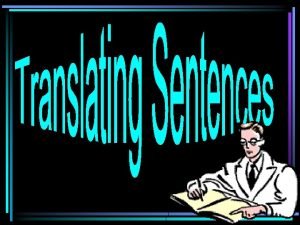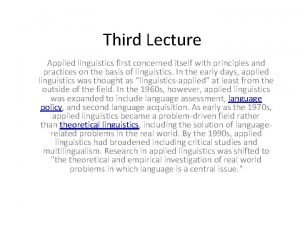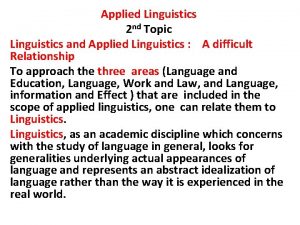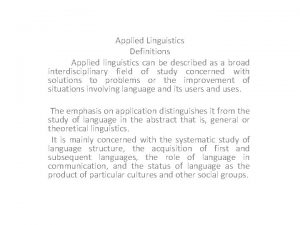Third Lecture Applied linguistics first concerned itself with





- Slides: 5

Third Lecture Applied linguistics first concerned itself with principles and practices on the basis of linguistics. In the early days, applied linguistics was thought as “linguistics-applied” at least from the outside of the field. In the 1960 s, however, applied linguistics was expanded to include language assessment, language policy, and second language acquisition. As early as the 1970 s, applied linguistics became a problem-driven field rather than theoretical linguistics, including the solution of languagerelated problems in the real world. By the 1990 s, applied linguistics had broadened including critical studies and multilingualism. Research in applied linguistics was shifted to "the theoretical and empirical investigation of real world problems in which language is a central issue. "

• In the United States, • applied linguistics also began narrowly as the application of insights from structural linguistics—first to the teaching of English in schools and subsequently to second and foreign language teaching. • The linguistics applied approach to language teaching was promulgated most strenuously by Leonard Bloomfield, who developed the foundation for the Army Specialized Training Program, and by Charles C. • Fries, who established the English Language Institute (ELI) at the University of Michigan in 1941. • In 1948, the Research Club at Michigan established Language Learning: A Journal of Applied Linguistics, the first journal to bear the term applied linguistics. • In the late 1960 s, applied linguistics began to establish its own identity as an interdisciplinary field of linguistics concerned with real-world language issues. The new identity was solidified by the creation of the American Association for Applied Linguistics in 1977.

The Scope of Applied Linguistics • The scope of applied linguistics includes: Language Acquisition (L 1 and L 2), Psycho / Neuro linguistics, Language Teaching, Sociolinguistics, Humor Studies, Pragmatics, Discourse Analysis / Rhetorics, Text / Processing / Translation, Computational Linguistics – Machine Translation, Corpus Linguistics, Language Control/Dialectology. • Beside the above explanation about the scope of applied linguistics, there are some other disciplines: 1. Language and Teaching This scope covers methods of language teaching. In doing teaching learning activity, linguistic is applied on those methods.

• Language and Society • The branch in this scope is called sociolinguistics. • Sociolinguistic studies about the relationship between the society and language, and explore/solve the problem related to society that affects the language, varieties of language in society, terms of taboos and euphemism, etc.

• 3. Language Education/Learning • This scope tries to explain about the first language education, additional language education such as second language education and foreign language education. It also help us to know about clinical linguistic and language testing. Clinical linguistic is the study about language disability. • 4. Language, Work and Law The scope of Language, Work and Law explain about communication in the workplace, language planning and forensic linguistic. • 5. Language, Information and Effect It studies the literary stylistics, critical discourse analysis, translation and interpretation, information design, and lexicography.









